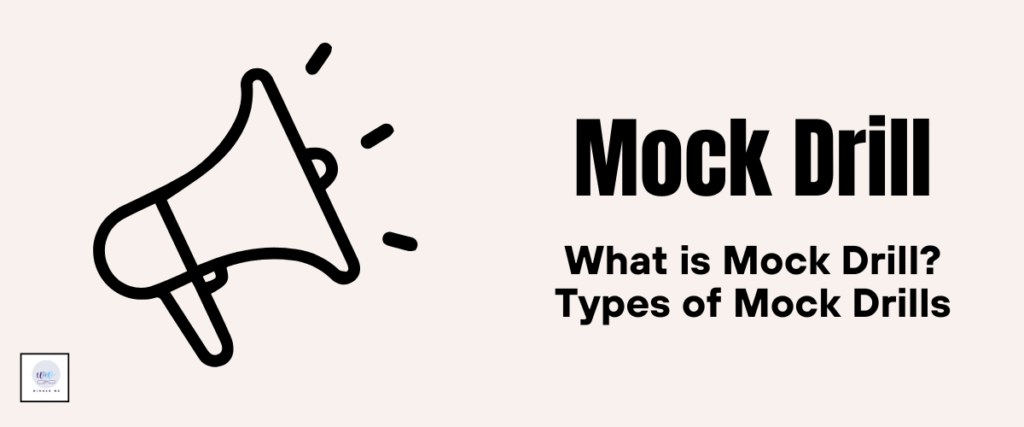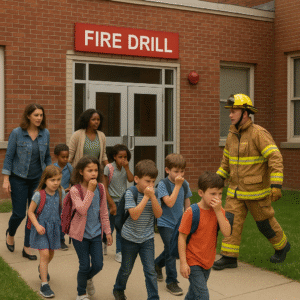
🧯 What is a Mock Drill? – Importance, Types, and Procedure Explained
📌 What is a Mock Drill? | Importance, Types & Procedure |
🔶 Introduction: What is a Mock Drill?
A mock drill is a simulated emergency situation conducted to evaluate and improve the preparedness and response capabilities of individuals, organizations, or institutions. It acts as a practice run for real-life emergencies such as fires, earthquakes, chemical spills, or terrorist attacks.
Think of it as a rehearsal to save lives.
🚨 Why Are Mock Drills Important?
Mock drills serve multiple critical purposes:
-
✅ Enhance Emergency Preparedness
-
✅ Train individuals to react quickly
-
✅ Identify gaps in safety systems
-
✅ Test effectiveness of evacuation plans
-
✅ Create awareness among staff, students, or residents
-
✅ Reduce panic during real disasters
Organizations that conduct regular mock drills have a significantly higher chance of minimizing loss during actual emergencies.
🔥 Types of Mock Drills
Here are some common types of mock drills conducted across industries:
| Drill Type | Purpose | Common Locations |
|---|---|---|
| Fire Drill | Simulates fire outbreak evacuation | Offices, Schools, Malls |
| Earthquake Drill | Teaches drop-cover-hold response | Schools, Government Offices |
| Chemical Spill Drill | For handling hazardous material leaks | Factories, Labs |
| Medical Emergency Drill | First aid, CPR, ambulance training | Hospitals, Schools |
| Terror Attack Drill | Evacuation and lockdown practice | Public Transport, Malls |
| Flood/Tsunami Drill | Evacuation and safety sheltering | Coastal Areas |
🏫 Mock Drill in Schools
Mock drills in schools are essential for:
-
Training students how to respond calmly
-
Helping teachers follow emergency protocols
-
Ensuring quick evacuation without chaos
Example: During a fire drill, a school bell may ring in a specific pattern. Students line up, cover their mouths, and walk to a safe zone without running.

🏢 Mock Drill at Workplace
Companies are required by safety regulations to conduct mock drills:
-
Fire evacuation routes are tested
-
Emergency response team roles are assigned
-
Employees learn how to use extinguishers
Many organizations conduct quarterly mock drills for compliance and insurance purposes.
🔄 Procedure of a Mock Drill – Step-by-Step
Here’s how a standard mock drill is conducted:
1️⃣ Planning Phase
-
Define the scenario (e.g., fire on 2nd floor)
-
Appoint observers and safety marshals
-
Inform selected participants secretly (or keep it a surprise)
2️⃣ Execution Phase
-
Trigger the alarm (bell or siren)
-
Begin evacuation
-
Employees/students move to assembly point
-
Safety team checks rooms and assists
3️⃣ Post-Drill Review
-
Head count at assembly point
-
Feedback from observers and team leaders
-
Identify bottlenecks, delays, and mistakes
-
Prepare improvement plan
🛑 Common Mistakes During a Mock Drill
-
Lack of proper planning
-
Panic among participants
-
Poor communication
-
Ignoring physically challenged individuals
-
No post-drill debrief
🧠 Tips for Effective Mock Drills
✅ Conduct drills regularly (quarterly or bi-annually)
✅ Train all participants properly
✅ Simulate real scenarios, not just theory
✅ Involve local emergency services
✅ Keep records for future audits or legal needs
📚 Conclusion
A mock drill may seem like a routine activity, but it plays a life-saving role in real emergencies. Whether it’s a school, office, hospital, or industrial site – being prepared means being safe.
“Failing to plan is planning to fail – especially during emergencies.”
